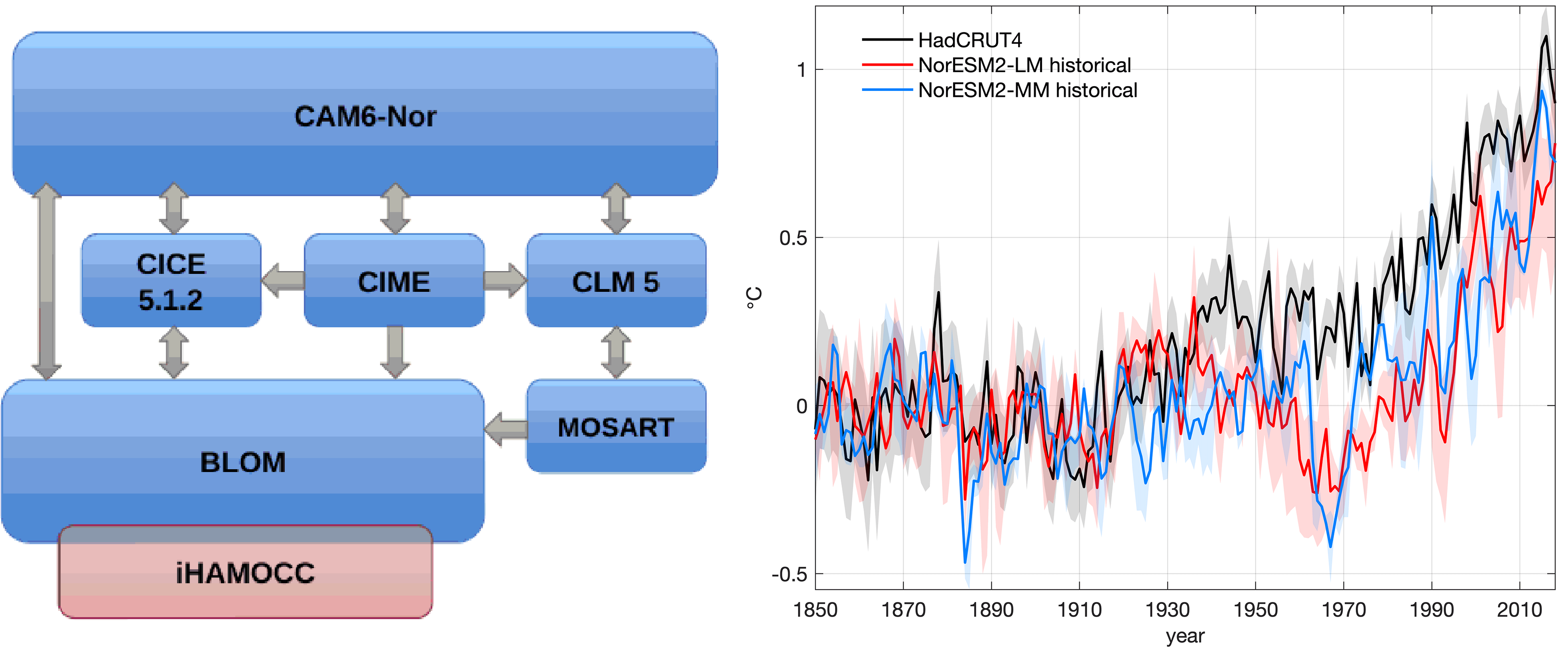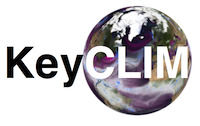The Norwegian Earth System Model (NorESM)
One of the main uncertainties in future climate projections is associated with process biases in the model (Hawkins and Sutton, 2009). Uncertainties in mechanisms perturbing the Earth radiation budget are the major causes of insufficient quantification in climate projections for a given emissions scenario. However, the coupled processes in the Earth system introduce considerable complexity, and uncertain regional climate projections. Thus the general approach of KeyCLIM consists of building on relevant NorESM expertise, contributing strongly to the Coupled Model Intercomparison Project (CMIP).
The Norwegian Earth System Model (NorESM; e.g. Bentsen et al., 2013; Iversen et al., 2013; Kirkevåg et al., 2013; Tjiputra et al., 2013, Schwinger et al., 2016; Tjiputra et al., 2019, Graff 2019, Seland et al. 2020) is a coupled Earth System Model developed by the Norwegian Climate Center (NCC). The model has been used in both the 5th and the 6th phases of CMIP (CMIP5, CMIP6), and for evaluation of the difference between a 1.5 and 2 deg. C warmer world than pre-industrial (Graff et al., 2019). NorESM is based on the Community Earth System Model CESM (Danabasoglu et al., 2020). Although large parts of NorESM are similar to CESM, there are several important differences: NorESM uses the isopycnic coordinate Bergen Layered Ocean Model (BLOM; Bentsen et al., in prep.), uses a different aerosol module OsloAero6 (Kirkevåg et al., 2018; Olivié et al., in prep.), contains specific modifications and tunings of the atmosphere component (Toniazzo et al., 2020), and contains the iHAMOCC model to describe ocean biogeochemistry (Tjiputra et al., 2020).
Visit the NorESM home page to learn more about the NorESM model system, model data products and related projects.
A thorough description of the NorESM model and a user guide can be found here .
The NorESM source code can be accessed here .
Overview of The Norwegian Earth System Model version 2 (NorESM2) used for the CMIP6 experiments.

References:
Seland, Ø., Bentsen, M., Seland Graff, L., Olivié, D., Toniazzo, T., Gjermundsen, A., Debernard, J. B., Gupta, A. K., He, Y., Kirkevåg, A., Schwinger, J., Tjiputra, J., Schancke Aas, K., Bethke, I., Fan, Y., Griesfeller, J., Grini, A., Guo, C., Ilicak, M., Hafsahl Karset, I. H., Landgren, O., Liakka, J., Onsum Moseid, K., Nummelin, A., Spensberger, C., Tang, H., Zhang, Z., Heinze, C., Iverson, T., and Schulz, M.: Overview of the Norwegian Earth System Model (NorESM2) and key climate response of CMIP6 DECK, historical, and scenario simulations, Geosci. Model Dev., https://doi.org/10.5194/gmd-13-6165-2020, 2020.
Gjermundsen, A., Nummelin, A., Olivié, D. et al. Shutdown of Southern Ocean convection controls long-term greenhouse gas-induced warming. Nat. Geosci. https://doi.org/10.1038/s41561-021-00825-x, 2021.
Tjiputra, J. F., Schwinger, J., Bentsen, M., Morée, A. L., Gao, S., Bethke, I., Heinze, C., Goris, N., Gupta, A., He, Y., Olivié, D., Seland, Ø., and Schulz, M.: Ocean biogeochemistry in the Norwegian Earth System Model version 2 (NorESM2), Geosci. Model Dev., https://doi.org/10.5194/gmd-13-2393-2020, 2020.
Toniazzo, T., Bentsen, M., Craig, C., Eaton, B., Edwards, J., Goldhaber, J., Jablonowski, C., and Lauritzen, P. J.: Enforcing conservation of axial angular momentum in the atmospheric general circulation model CAM6, Geosci. Model Dev. , https://doi.org/10.5194/gmd-13-685-2020, 2020.
Bentsen, M., Bethke, I., Debernard, J. B., Iversen, T., Kirkevåg, A., Seland, Ø., Drange, H., Roelandt, C., Seierstad, I. A., Hoose, C., and Kristjánsson, J. E.: The Norwegian Earth System Model, NorESM1-M – Part 1: Description and basic evaluation of the physical climate, Geosci. Model Dev., 6, 687–720, https://www.geosci-model-dev.net/6/687/2013/, 2013.
Danabasoglu, G., Lamarque, J.-F., Bacmeister, J., Bailey, D. A., DuVivier, A. K., Edwards, J., Emmons, L. K., Fasullo, J., Garcia, R., Gettelman, A., Hannay, C., Holland, M. M., Large, W. G., Lawrence, D. M., Lenaerts, J. T. M., Lindsay, K., Lipscomb, W. H., Mills, M. J., Neale, R., Oleson, K. W., Otto-Bliesner, B., Phillips, A. S., Sacks, W., Tilmes, S., van Kampenhout, L., Vertenstein, M., Bertini, A., Dennis, J., Deser, C., Fischer, C., Fox-Kemper, B., Kay, J. E., Kinnison, D., Kushner, P. J., Long, M. C., Mickelson, S., Moore, J. K., Nienhouse, E., Polvani, L., Rasch, P. J., and Strand, W. G.: The Community Earth System Model version 2 (CESM2), J. Adv. Model. Earth Syst., https://doi.org/10.1029/2019MS001916, 2020.
Graff, L. S., Iversen, T., Bethke, I., Debernard, J. B., Seland, Ø., Bentsen, M., Kirkevåg, A., Li, C., and Olivié, D. J. L.: Arctic amplification under global warming of 1.5 and 2 ◦C in NorESM1-Happi, Earth System Dynamics, 10, 569–598, https://www.earth-syst-dynam.net/10/569/2019/, 2019.
Iversen, T., Bentsen, M., Bethke, I., Debernard, J. B., Kirkevåg, A., Seland, Ø., Drange, H., Kristjansson, J. E., Medhaug, I., Sand, M., and Seierstad, I. A.: The Norwegian Earth System Model, NorESM1-M – Part 2: Climate response and scenario projections, Geosci. Model Dev., 6, 389–415, https://doi.org/10.5194/gmd-6-389-2013, 2013.
Kirkevåg, A., Iversen, T., Seland, Ø., Hoose, C., Kristjánsson, J. E., Struthers, H., Ekman, A. M. L., Ghan, S., Griesfeller, J., Nilsson, E. D., and Schulz, M.: Aerosol–climate interactions in the Norwegian Earth System Model – NorESM1-M, Geosci. Model Dev., 6, 207–244, https://doi.org/10.5194/gmd-6-207-2013, 2013.
Kirkevåg, A., Grini, A., Olivié, D., Seland, Ø., Alterskjær, K., Hummel, M., Karset, I. H. H., Lewinschal, A., Liu, X., Makkonen, R., Bethke, I., Griesfeller, J., Schulz, M., and Iversen, T.: A production-tagged aerosol module for Earth system models, OsloAero5.3 – extensions and updates for CAM5.3-Oslo, Geosci. Model Dev., 11, 3945–3982, https://doi.org/10.5194/gmd-11-3945-2018, 2018.
Morice, C. P., Kennedy, J. J., Rayner, N. A., and Jones, P. D.: Quantifying uncertainties in global and regional temperature change using an ensemble of observational estimates: The HadCRUT4 dataset, J. Geophys. Res.-Atmos., 117, D08101, https://doi.org/10.1029/2011JD017187, 2012.




